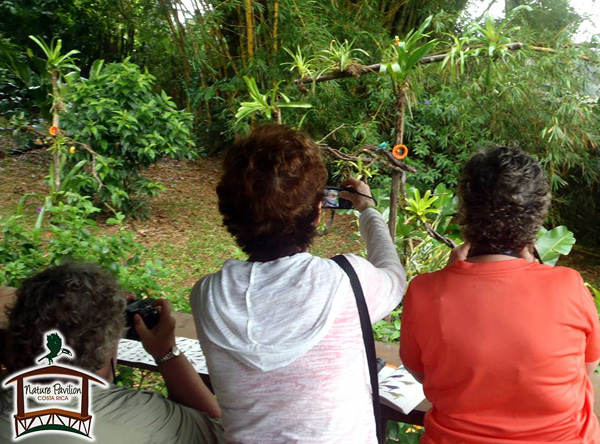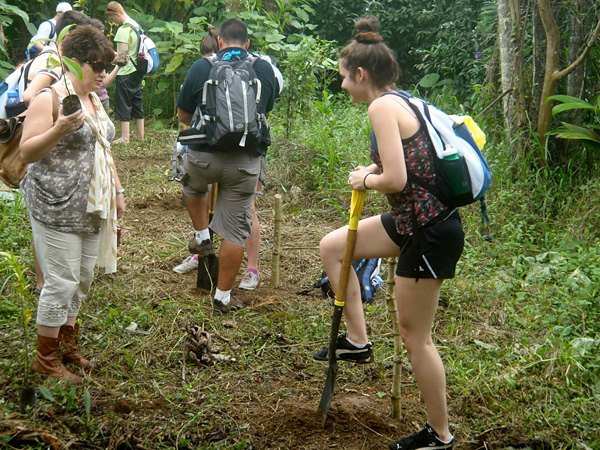Oil palm plantations have been rapidly expanding across the tropics for the better part of the past twenty years due to high returns from palm oil production. But palm oil isn’t necessarily the most profitable form of land use in wildlife-rich areas, as one conservation entrepreneur is demonstrating in Costa Rica.
David Lando Ramirez, a landowner in Sarapiqui, northeastern Costa Rica, has converted a small patch of oil palm into a thriving ecotourism business centered around people’s love of the Central American nation’s stunning diversity of wildlife. Ramirez’s Nature Pavilion offers nature trails, conservation activities like tree-planting, and facilities to view birds, poison dart frogs, and other wildlife. Visitors can see dozens of species of birds during a single day trip — over 230 types of birds have been recorded at the site, nearly a quarter of the total number found in the United States.
In an October interview with Mongabay.com, Ramirez talked about his venture, including efforts to increase environmental awareness through education in the region.

View from the Nature Pavilion viewing balcony overlooking 25 years of successful reforestation
Mongabay.com: What led you to Costa Rica?
David Lando Ramirez: My mother, Zeneida Ramirez, was born and raised in a small rural village in Sarapiqui in northeastern Costa Rica. My father, David Lando, graduated from UC Berkeley in 1972 and looking for adventure left California and arrived in Costa Rica in 1976 where he met and married my mother. They worked together administrating large agricultural farms and started our family. In 1985 my parents purchased 6 hectares of a bankrupted African oil palm plantation in Sarapiqui and thus began our work with reforestation.
I was led to Costa Rica and to this project in particular with a desire and passion to transform the family property into a sustainable tourism business. My goal was to generate capital to acquire more land in order to expand the reforestation project.

David Lando and his son David Lando Ramirez.
Mongabay.com: What was your background prior to coming to Costa Rica?
David Lando Ramirez: When my two older sisters and I were school age my parents moved our family to the San Francisco Bay Area for our education. We spent summer vacations on the family property actively involved in reforestation. After graduating from Woodside Priory School in 2001 I began my 4 year college career at Santa Clara University. My double major in Environmental Studies and Anthropology helped to prepare me for my return to our reforestation project in 2008.
Mongabay.com: What was the state of your land when you acquired it?
David Lando Ramirez: The 6-hectare section of land that my parents purchased was part of the remains of an abandoned African oil palm plantation that had covered over 1,000 hectares.
Mongabay.com: How did you come to establish Nature Pavilion?
David Lando Ramirez: The idea to transform the family property into a sustainable tourism venue arose from the desire to channel tourism revenue into expanding the wildlife habitat. To maximize the impact and reach I set out to design nature tour experiences that every tourist in Costa Rica would be able to enjoy. The success is based on a simple model of providing awesome wildlife viewing with comfort and convenience. I custom designed wooden viewing decks to provide guests with comfortable and safe viewing of wildlife where wild toucans, poison dart frogs, hummingbirds and iguanas venture in from the surrounding rainforest and can be seen just meters away.

The Nature Pavilion experience promotes environmental awareness through these kinds of exciting up-close and personal encounters with nature. These experiences in turn provide guests with an appreciation for the vital role reforestation plays in the environment.
Mongabay.com: How is it coming so far?
David Lando Ramirez: The Nature Pavilion has exceeded my expectations during the first 2 years in business. Thousands of visitors from around the world have enjoyed the Nature Pavilion experience and contributed to our reforestation efforts. Revenues generated from these visits and from donations is helping us make progress towards our goal of acquiring land and increasing more wildlife habitat. Student groups and families from North America and Europe have helped to plant over 1,500 trees in our reserve. Our ongoing reforestation is now providing a home and feeding grounds for over 230 species of birds.

Tree-planting activity at the Nature Pavilion
The quality of the tours that we offer here at the Nature Pavilion has been recognized by groups such as the Organization for Tropical Studies and Rainforest Alliance. We have also been featured and listed in the National Geographic Traveler and recommended by Rainforest Alliance for sustainability on their SustainableTrip.org website.
Mongabay.com: How do most visitors find you?
David Lando Ramirez: Many first time visitors find us simply by following our road signs. Our location on the main highway connecting two of Costa Rica’s most popular tourist attractions ensures us high visibility. By far our most successful advertising is the word of mouth from guests who have enjoyed their experience and recommend it to fellow travelers. Guests also share and rank their experience online via the traveler review site TripAdvisor . Our website www.costaricanp.com, Facebook, Youtube and Flickr pages help us to increase our visibility online. Many visitors are also now finding us when they book through travel agencies which recommend a stop at the Nature Pavilion.

Toucan taking flight. Photo by Jan Pedersen
Mongabay.com: How does Nature Pavilion contribute to conservation?
David Lando Ramirez: With each tree planted guests help bring Costa Rica closer to the goal of carbon neutrality. The Organization for Tropical Studies (OTS) coordinates with us for reforestation. Research scientists of the OTS perform land studies and advise the Nature Pavilion on the best species of trees to plant to maintain the ecological balance of our 4 habitats. The Costa Rican government offers corporations a tax incentive to volunteer their workers for tree planting. The OTS sends a bus to pick up the workers, stops by a nursery for trees then drives to our Nature Pavilion to plant on our island in the Sarapiqui River. The tree planting is followed by a delicious cultural lunch with a vegan option. Everyone wins. The corporation pays less tax while workers enjoy a free day in the countryside planting trees. The impact of planting a tree to increase wildlife habitat is an empowering experience for them as they realize that because of their action hundreds of species of animals and plants will continue to thrive for decades and centuries. The workers leave the Nature Pavilion with the understanding of how the action of one person in one hour can revitalize a forest for generations to come.
We also invite local school children and their families to plant trees on Earth Day and help them to understand the importance of being stewards of the land.

Mongabay.com: What’s next for you?
David Lando Ramirez: The goal of the Nature Pavilion is to acquire more land and expand the reforestation project to reclaim more habitat. Our passion for protecting and increasing habitat will continue to shape the future and direction of the Nature Pavilion. New nature tours will be rolled out in 2014 along with the opening of a new lunch venue overlooking the Sarapiqui River. The more visitors we attract to the Nature Pavilion the more we can increase the wildlife habitats of Costa Rica.
If you are planning a trip to Costa Rica we invite you to stop by and support our project simply by enjoying our tours. For more information visit our website www.costaricanp.com.
Related articles